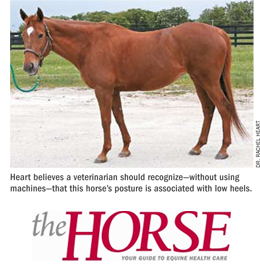It happens all the time, your perfectly normal horse suddenly becomes an unsound horse or a resistant horse and nobody seems to know what happened. Sometimes your veterinarian can’t even find the problem. Sometimes even the most advanced diagnostic techniques are not providing an answer as to why your horse is unsound or resistant. A lot of times the horse may show a good clinical response to certain therapies or rest but return to normal work and problems return as well.
This scenario can be extremely frustrating to clients who are both emotionally and financially invested in their horses. At Heart Equine we recognize the multi-factorial origin of most lameness’s and feel the solution is in treating the problem before it is manifested in the horse’s gait or behavior. One way of doing this is learning to recognize compensation.
Recognizing Compensation
Horses are masters of compensation and many will contort their bodies and change their gait in such ways to hide all evidence of pain. There are far too many people in this sport who accept the horse’s willingness as an sign that it is pain free and ignore the subtle indications that it having a problem. Often things that we accept about our horses (sometimes we even purchase these abnormalities) such as a very uncomfortable canter in one direction, trouble turning left, or a difficult lead change are really just different ways of trying to cope with an underlying problem. If your horse starts to develop these subtle problems it is likely that he is compensating. Many of our sport horse live in a world of chronic compensation and often just increasing their job stress a little will turn them into inconsistent performers.
Treating Compensation
A horse that is compensating will be unable to develop proper muscling over its body because its body is not being used properly. So when this horse becomes lame he has habits that support the compensatory gait. For example if a horse always loads the left front foot more than the right front foot and he goes lame in the left front foot… it will be harder to make that foot better if you cannot change the horse’s habits. This is often why there is no diagnosis but healing does not happen either. Lameness is often an end result of chronic compensating. Learning to recognize and treat compensation is key to preventing gaits and behaviors that negatively affect performance.
Preventing Injury
A trainer had me look at a horse being ridden by its owner and said to me ‘ This horse is not lame but there is something wrong. He is drifting right and I am worried he might start stopping with his owner who is an amateur.
My observation of the horse was that he was short strided in both front and rear limbs and carried the right rear leg more extended. His back did not move at all and he did not look especially happy. The horse however had no visible limp but to me he was obviously not comfortable and was travelling as if he had pain somewhere.
An examination of this animal showed it to have some distal limb joint pain as well as some changes in the alignment of his thoracic and lumbar spine leading to some back pain. This horse was not painful enough to show lameness but he had a compensatory gait that was recognized as being abnormal. Once this horse’s back was treated and distal limb joints aligned this horse’s stride lengthened and he straightened out on his approach to fences. Had this horse not been treated at this time a more serious problem may have evolved.
Learning to identify compensation can have profound effects on maintaining your horse’s soundness.




 Entering 2011, it’s hard to believe that my 20–year veterinary school reunion is now only months away. What an evolution our profession has seen with the advances in technology. The way we learn, communicate, and diagnose has changed, and the advantages are many. These days, as a veterinarian, it is not unusual to walk into a barn and set up more than $100,000 in equipment to do a routine exam. We have digital radiography, computerized radiography, ultrasound, and even lameness locators. Veterinarians have become very adept at using equipment to make an exact diagnosis…
Entering 2011, it’s hard to believe that my 20–year veterinary school reunion is now only months away. What an evolution our profession has seen with the advances in technology. The way we learn, communicate, and diagnose has changed, and the advantages are many. These days, as a veterinarian, it is not unusual to walk into a barn and set up more than $100,000 in equipment to do a routine exam. We have digital radiography, computerized radiography, ultrasound, and even lameness locators. Veterinarians have become very adept at using equipment to make an exact diagnosis…